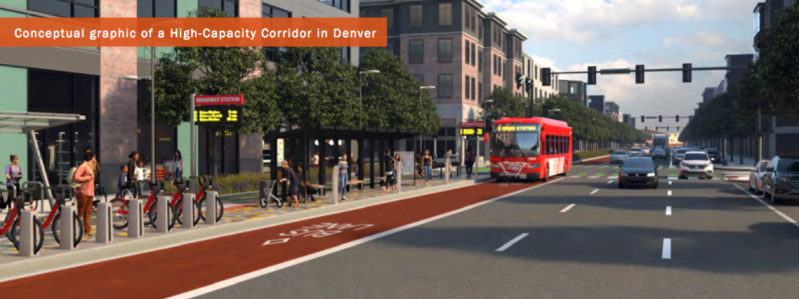It’ll Be a While Before Denverites See Gains from City’s First-Ever Transit Plan, Unveiled Monday
What the 20-year plan for better bus and rail service does and doesn't do.

The last 60 years of Denver’s development has tethered entire generations of people to personal cars. The next 21 will be, supposedly, about cutting that cord. This post is the second in a series examining how the city’s “Denveright” plans might — or might not — make walking, biking, and transit legitimate options for everyone. These plans are in draft form. You can comment through October 31.
Two years after the Hancock administration set out to reshape the city’s bus and train network with Denver’s first-ever transit plan, Denverites still don’t know precisely how much it will cost, where the money will come from, or what will be built where by when.
While important pieces remain undefined, the plan provides a framework that positions Denver to vastly improve the urban transit network, a responsibility once solely on the shoulders of the Regional Transportation District.
Those are some revelations following Monday’s unveiling of “Denver Moves: Transit,” one of five documents released after the massive citywide planning process known as Denveright, launched in 2016.

The 454-page plan identifies 19 corridors due for small, medium, and large investments over the next 20 years. The goal? Create a frequent transit network where buses and trains come every five to 15 minutes.
Within five years, residents will see marginal improvements to some bus corridors with more frequent service, the plan states, possibly by paying RTD for operations. But it will be 2040 by the time Denverites see overhauls to just five corridors slated for major investments — think Colfax bus rapid transit or streetcars — out of 13 identified.
During a meeting with reporters last week, city officials insisted the transit plan is strictly an “aspirational” document meant to point Denver in the right direction. City documents, however, show funding mechanisms, implementation strategy, and project prioritization as intended deliverables [PDF].
“We kind of set out some scenarios here, and starting from that point, the next step is to get into the true implementation and strategy of those scenarios,” Denver Public Works Executive Director Eulois Cleckley said. “So it takes more time and more energy and more effort and more analysis to get there.”

The build-out of a platinum-level transit network with lots of bus lanes, bus rapid transit, streetcars or light rail, signal priority, and bus stop upgrades would cost $5 billion, according to very rough estimates in the plan. The bare-bones version would cost $1 billion.
Denver Moves: Transit does not recommend funding sources to pursue, like a massive tax measure or higher fees from parking meters. Instead, the Hancock administration will begin a “phase 2” that examines funding options, refines costs, and prioritizes projects.
A first-time focus on transit
Denver Public Works has just one person working on transit issues full-time, and she was hired to manage this plan. Denver Moves: Transit calls for the establishment of a “transit program.” Essentially, this means that transit stuff will receive the same treatment as bike and pedestrian stuff. Engineers and planners will be hired to improve streets, policies, and funding for bus and rail service.
“I think the best way to articulate it is that the department’s gonna put a greater focus on transit,” Cleckley said. “We’re looking at how the Department of Public Works is organized and one of the aspects of what we’re gonna be focused on is making sure we have the right amount of resources that are going to be focused towards transit.”
Cleckley would not say how many employees the department will hire, but he will request the funds from Mayor Michael Hancock this budget season.
A new relationship with RTD
A bus caught in general traffic lanes won’t be on time, but RTD can’t just order up a bus lane whenever it wants. The city, not the transit agency, controls the streets that dictate whether RTD serves Denverites well.
“There’s definitely a recognition that RTD may not be in the best position to provide all of the bold recommendations out of this plan, but we do need to take the time to really explore where those opportunities are to lean in,” Cleckley said. “I think all options are on the table.”
Paying for extra RTD service is one option. But the agency can’t even hire enough bus drivers to deliver on the current service promised to riders. Regardless, the city and RTD will have to work much closer together in order to pull off upgrades.
The transit plan still isn’t done
The documents released today are technically drafts for the public to review and comment on before being finalized.
Stay tuned for coverage of this plan, as well as the Denveright plans for pedestrians and land use.


